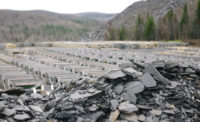
This is a report of the third visit by Architectural Roofing & Waterproofing and Roofing Contractor to China. Why China? The answer becomes clearer as the years so by. Most folks in the United States recognize that we are part of a world economy - a world economy in which China looms larger as it continues to grow.
The roofing industry in the United States has been influenced for years by the development of material and equipment technologies overseas, particularly in Europe. A few quick examples would be the introduction of modified bitumen roofing and computerized metal-folding machines. Due to longstanding and stable political relationships between the United States and Europe, industry ties have developed quite naturally. With an improving relationship between the United States and China over the past several decades, a number of alliances have been able to form between industry interests in both countries.

Rick
Damato
visited the Suzhou Waterproof Material Research and Design Institute in Suzhou.
Suzhou is known as “the Venice of China.”
From our first visit in 2004 to the latest at the end of 2009, there is a growing body of evidence that the goal of the Chinese roofing and waterproofing industry to become world class is moving toward fruition. Our journey this time was not to partake in an expo, but to visit the Suzhou Waterproof Material Research and Design Institute. The Institute is broken into four main groups: Research and Development, Inspection, Design, and Communication (including China Building Waterproofing magazine and the new startup, Roofing Engineering).
The institute is affiliated with the China Building Materials Academy and is wholly owned by China Building Material Waterproof Materials Company. The institute is mainly engaged in research and development of roofing and waterproofing materials, promotion and application of new products and new technologies, as well as design, installation and startup of bitumen membrane production lines.

Roofing
membrane and insulation is staged for wind uplift testing at the FM
Approvals-designed lab a few miles from the headquarters of the institute in Suzhou.
The Institute has a variety of missions, including inspections. Part of the institute, the Building Waterproofing Materials Supervision and Inspection Center is a state-authorized third-party statutory inspection body. There are a variety of testing labs at the headquarters location and include labs for coatings, cements, hazardous materials (VOCs, for example), rigid materials, insulation, and asphalt shingles. A set of standards for asphalt shingles was implemented in 2008. Among the latest initiatives launched by the institute is a joint venture with FM Approvals, Norwood, Mass. After exhaustive study of wind-uplift testing standards all over the world, the institute settled on FM4471 as the standard of choice.
According to FM Approvals Assistant Vice-President – Director of Materials, George A. Smith, P.E., the Institute contacted FM Approvals less than a year ago about a joint agreement to build an FM Approvals-designed lab to run wind-uplift testing in China. Once the agreement was reached, Smith was amazed to learn that they were able to get the site up and operating in record time. Architectural Roofing & Waterproofing and Roofing Contractor were invited to visit the lab, which is located in a site just a few miles from the headquarters of the institute in Suzhou. The lab contains a variety of testing facilities designed by the Institute, including wind testing for asphalt shingles and wind and water testing for curtain-wall systems.
While we were in Suzhou, FM Approvals Senior Engineering Specialist - Materials Group, John P. Cauley, P.E., was on site along with Francis Zhang, Approvals Engineer, from FM Approvals’ Shanghai office. A series of tests were being scheduled on a variety of roof and insulation systems over steel deck. The tests were to be conducted in Suzhou and around the same time at the FM Approvals testing facility in the United States using the same material. The purpose was to determine the quality of the Suzhou installation. In addition to the lab being used by the Institute, FM Approvals will likewise be able to use the Suzhou facility to conduct testing on its own. With a lab located in China, FM Approvals will be able to greatly reduce the expense and time associated with shipping materials to the US for testing related to projects in China and other parts of Asia.
We asked Smith about the key difference in the Chinese approach to built space insurance vs. the U.S. approach, and he said, “I think the Chinese are still developing their approach to building standards.” The Institute initially approached FM Approvals to understand the process and to obtain help with building standards. This lab is evidence that the Chinese are moving forward with the process and with a studied but fast-track approach.
According to Smith, the tests conducted in both sites were “spot on”. He went on to tell us he was very pleased with the job the Chinese did building the lab to FM Approvals specifications. FM Approvals has similar initiatives at work in other parts of Asia, including Korea and India.

The
lab contains a variety of testing facilities designed by the institute. Here
sections of metal deck are prepared for the test stand.
We visited Suzhou and the Institute on the kind invitation of China Building Waterproofing and Roofing Engineering magazines, led by Ms. Xu Jianyue. The writer must also acknowledge his good friend, Mr. G.Q. Zhao, who serves as the English-language translator for the publications and our good host and translator while in Suzhou. Being in the publishing business for the roofing industry in our respective countries, we were able to enjoy a good meeting discussing the goals of our various publications.
Roofing Engineering is a startup publication and will publish six times in 2010 while CBW will increase from 12 to 18 issues in 2010. This reflects not only continuing growth in the construction industry in China but also a maturing of the building industry as some contractors and material manufacturers are beginning to specialize in roofing. In our earlier reports we noted that the divisions of construction disciplines in China are not as distinct as they are in the United States and Europe, but we get a sense that this is changing. Improved building standards will continue to drive this change as installing roofing systems will become more and more complex and specialized much as it is here and in Europe.

Rick
Damato’s
friend, Mr. G.Q. Zhao, who serves as the English-language translator for the
publications China Building Waterproofing and Roofing Engineering, served as
the translator for Damato while he was in Suzhou.
We will also continue to export more of our building systems science and technology. The market in China is massive and the demands for built space are great. We may not think of roofing and construction in terms of the world economy, but this report should tell you one thing if nothing else: the roofing and building industry really is part of a global economy. So we end by saying, “to be continued,” as our next trip to this part of the world will include a further report on roofing materials manufacturing and the construction process.

